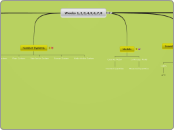Addition of integers
Subtraction of integers
Multiplication of integers
Decimals
Percents
Closure Property of Multiplication
Commutative Property of Multiplication
Identity Property of Multiplication
Inverse Property of Multiplication
Closure Property of Addition
Communative Property of Addition
Identity Property of Addition
Utilizing
Ratio Sense
Rational Numbers
Recognition of quantities and how they change
Relative thinking.
Where two ratios are equal.
Comparing two quantities regardless of whether units are the same.
Repeated Subtraction
Partition
Area Model
Interpretations of a fraction
Part-Whole interpretation
Copies
Division
Separating groups
Ratios
Comparing 2 separate things
Rational Numbers
Any number that can be expressed as the quotient of two integers. a/b
Use of Cuisennaire Rods
Understand the Problem
Devise A Plan
Implement you Plan
Arithmetic Sequence
Geometric Sequence
Recurrence Relationship Sequence
Venn Diagram
Universal Set
Conjoined Set
Complements
Equivalent Sets
Equal Sets
Tally System
Egyptian System
Myan System
Babylonian System
Roman System
Hindu-Arabic System
Discrete Model
Counted Quantities
Continuous Model
Measured Quantities
Bases
Cubes
a^3
Flats
a^2
Longs
a^1
Units
1Unit
Closure Property of Addition
If aeX and beX then a+beX
Communative Property of Whole Numbers
If aeW and beW then a+b=b+a
Associative Property of Whole Numbers
If aeW, beW and ceW, then (a+b)+c=a+(b+c)=(a+c)+b
Identity Property of Division of Whole Numbers
If aeW then a+o=a=o+a
Partition: Equal Sharing
Characterizing by distributing a given quantity among a specified number of groups(partition) and determining the size(amount) in each group(partition).
Know: Quantity of #'s starting with, and # of groups
Find: Size of each group
Measurement
Characterized by using a given quantity to create groups(partitions) of a specified size(amount) and determining the # of groups that are formed.
Know: Quantity, and size of each group
Find: # of groups
Associative Property (grouping)
(axb)xc = ax(bxc)
Communicative Property
If aeW and beW, then ab = ba
Closure Property
If aeW and beW, then abeW
Identity Property
aeW, 1xa=a, 1 is the identity element
Zero Property
aeW, oxa=o
Distributive Property
aeW, beW, ceW, then a(b+c) = ab+ac
Closure Property (doesn't always work)
If aeW and beW, then (a-b)eW
Communative Property (doesn't always work)
If aeW and beW then a-b = b-a
Identity Property
If aeW then a-o = o-a
Odd Numbers
An even number + 1
Even Numbers
Multiples of 2
Prime Numbers
Only divisible by 1 and itself
Composite Numbers
Has a positive factor other than 1 and itself
Fundamental Theorem of Arithmetic
Means you can't find more than one prime factorization for a number.
